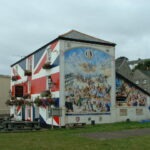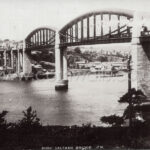Saltash is a historic town located in Cornwall, England, situated on the west bank of the River Tamar. Its rich history dates back to ancient times, making it an intriguing place to explore. I shall attempt to delve into the captivating history of Saltash, uncovering the significant events and developments that shaped this town into what it is today.

The origins of Saltash can be traced back to the Bronze Age when its natural salt pans began to attract settlers. These salt pans provided a valuable commodity, and the town flourished as a result. As time went on, the Romans recognized the strategic importance of Saltash due to its proximity to the Tamar Estuary and established a fort rebuilt by Robert, Count of Mortain, named Trematon Castle. This fort became a vital link in the Roman road system, connecting Cornwall to the rest of Roman Britain.
The development of Saltash continued throughout the centuries. During the medieval period, the town gained importance as a major trading center for tin and other minerals from the neighbouring mining regions. Its proximity to Plymouth also facilitated trade with other coastal towns and gave Saltash a strong maritime influence. This bustling trade brought wealth to the town and led to the construction of notable buildings, such as the Guildhall, which still stands today.
Saltash also played a significant role in English history. The town was a Royalist stronghold during the English Civil War. In 1643, it suffered a devastating siege by Parliamentarian forces. The Royalist garrison held out for several months before finally surrendering. This event had a lasting impact on Saltash, with many of its buildings and walls damaged. Nevertheless, the town managed to rebuild and thrive in the post-war years.
In the 19th century, Saltash underwent significant changes with the construction of the Royal Albert Bridge. Designed by Isambard Kingdom Brunel, this iconic bridge connects Saltash to Plymouth and revolutionized transportation in the region. The railway line, facilitated by the bridge, spurred industrial growth in Saltash, bringing prosperity and new opportunities to the town.
The modern era brought with it more changes and developments for Saltash. The town expanded its residential areas and experienced an increase in population. Additionally, improvements in infrastructure, such as the construction of the A38 road bridge and a tunnel under Saltash Town, further enhanced connectivity to neighbouring areas. The expansion of the nearby naval base at Devonport also impacted Saltash’s economy, as many service personnel and their families settled in the town.
In recent years, Saltash has focused on preserving its rich heritage and maintaining its historical charm. The town has designated conservation areas and implemented various restoration projects to protect its historic buildings and landmarks. Saltash Museum offers visitors a glimpse into the town’s past, showcasing artefacts and displays that depict its fascinating history.
Today, Saltash has evolved into a flourishing town that seamlessly blends the past with the present. Its historic waterfront, narrow streets, and ancient buildings provide a nostalgic charm to residents and visitors alike. The town continues to celebrate its history through various festivals and events, including Saltash May Fair and Saltash Regatta, which highlight its maritime roots.
The history of Saltash is a testament to its resilience and adaptability. From its humble beginnings as a salt-producing settlement to its prosperous medieval trade center, Saltash has weathered both triumphs and challenges. Its strategic location, architectural landmarks, and cultural heritage make it a town that embraces its past while looking towards a vibrant future.









